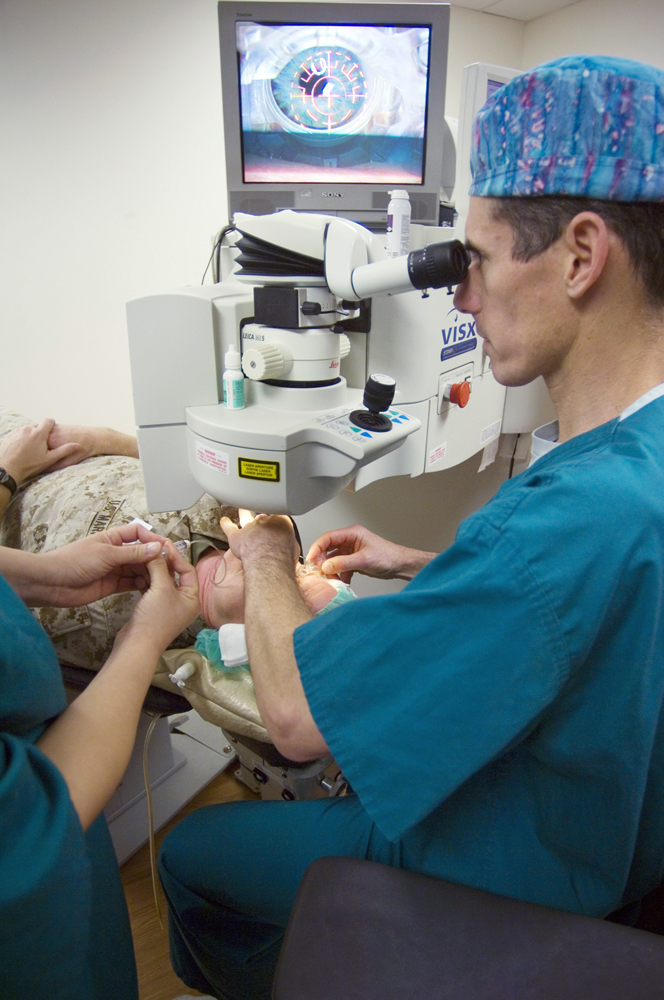| << Chapter < Page | Chapter >> Page > |

It has become common to replace the cataract-clouded lens of the eye with an internal lens. This intraocular lens can be chosen so that the person has perfect distant vision. Will the person be able to read without glasses? If the person was nearsighted, is the power of the intraocular lens greater or less than the removed lens?
If the cornea is to be reshaped (this can be done surgically or with contact lenses) to correct myopia, should its curvature be made greater or smaller? Explain. Also explain how hyperopia can be corrected.
If there is a fixed percent uncertainty in LASIK reshaping of the cornea, why would you expect those people with the greatest correction to have a poorer chance of normal distant vision after the procedure?
A person with presbyopia has lost some or all of the ability to accommodate the power of the eye. If such a person’s distant vision is corrected with LASIK, will she still need reading glasses? Explain.
What is the far point of a person whose eyes have a relaxed power of 50.5 D?
2.00 m
What is the near point of a person whose eyes have an accommodated power of 53.5 D?
(a) A laser vision correction reshaping the cornea of a myopic patient reduces the power of his eye by 9.00 D, with a uncertainty in the final correction. What is the range of diopters for spectacle lenses that this person might need after LASIK procedure? (b) Was the person nearsighted or farsighted before the procedure? How do you know?
(a)
(b) The person was nearsighted because the patient was myopic and the power was reduced.
In a LASIK vision correction, the power of a patient’s eye is increased by 3.00 D. Assuming this produces normal close vision, what was the patient’s near point before the procedure?
What was the previous far point of a patient who had laser vision correction that reduced the power of her eye by 7.00 D, producing normal distant vision for her?
0.143 m
A severely myopic patient has a far point of 5.00 cm. By how many diopters should the power of his eye be reduced in laser vision correction to obtain normal distant vision for him?
A student’s eyes, while reading the blackboard, have a power of 51.0 D. How far is the board from his eyes?
1.00 m
The power of a physician’s eyes is 53.0 D while examining a patient. How far from her eyes is the feature being examined?
A young woman with normal distant vision has a 10.0% ability to accommodate (that is, increase) the power of her eyes. What is the closest object she can see clearly?
20.0 cm
The far point of a myopic administrator is 50.0 cm. (a) What is the relaxed power of his eyes? (b) If he has the normal 8.00% ability to accommodate, what is the closest object he can see clearly?
A very myopic man has a far point of 20.0 cm. What power contact lens (when on the eye) will correct his distant vision?
Repeat the previous problem for eyeglasses held 1.50 cm from the eyes.
A myopic person sees that her contact lens prescription is . What is her far point?
25.0 cm
Repeat the previous problem for glasses that are 1.75 cm from the eyes.
The contact lens prescription for a mildly farsighted person is 0.750 D, and the person has a near point of 29.0 cm. What is the power of the tear layer between the cornea and the lens if the correction is ideal, taking the tear layer into account?
A nearsighted man cannot see objects clearly beyond 20 cm from his eyes. How close must he stand to a mirror in order to see what he is doing when he shaves?
A mother sees that her child’s contact lens prescription is 0.750 D. What is the child’s near point?
30.8 cm
Repeat the previous problem for glasses that are 2.20 cm from the eyes.
The contact lens prescription for a nearsighted person is and the person has a far point of 22.5 cm. What is the power of the tear layer between the cornea and the lens if the correction is ideal, taking the tear layer into account?
Unreasonable Results
A boy has a near point of 50 cm and a far point of 500 cm. Will a lens correct his far point to infinity?

Notification Switch
Would you like to follow the 'College physics' conversation and receive update notifications?